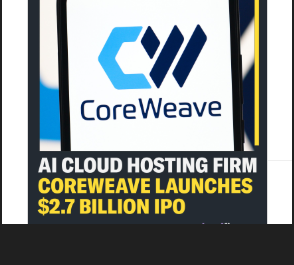Few names have generated as much interest—and discussion—as CoreWeave in recent months. This GPU-focused cloud startup has become a force to be reckoned with in tech-finance circles as the explosion of artificial intelligence changes the way we build, analyze, and even think. Many see CoreWeave’s impending IPO, which is valued at an eye-opening $2.7 billion, as a representation of the rapidly developing field of artificial intelligence. But is CoreWeave just the newest gimmick in an algorithm-driven pan, or is it a wise investment?
By renting out powerful GPUs that are necessary for AI model training, CoreWeave addresses a particular and expanding infrastructure chain gap. As the backstage crew for AI’s main act, it improves the speed, quality, and computational depth of generative tools. Its revenue increased by an incredible 736% to $1.9 billion in 2024 alone. However, that expansion came at a hefty cost—a net loss of $863 million—which caused investment boards to take notice. Despite its success, the company has a surprisingly small clientele—just two customers generate 77% of its revenue. A startling 62% is represented by Microsoft alone. That’s like trying to balance on one plank in a rising tide for investors.
| Category | Details |
|---|---|
| Company Name | CoreWeave Inc. |
| Founded | 2017 |
| Headquarters | Roseland, New Jersey, USA |
| Industry | Cloud Computing, AI Infrastructure |
| Core Offering | GPU rentals for AI, VFX, and compute-intensive workloads |
| IPO Valuation (2025) | ~$2.7 billion |
| Key Strategic Partner | Nvidia Corporation |
| Revenue (2024) | $1.9 billion |
| Net Loss (2024) | $863 million |
| Customer Concentration | Microsoft (62%), Top 2 clients = 77% of total revenue |
| Reference | SEC Filing |
A Potential Infrastructure Investment—With Caution
Many tech unicorns have adopted the “grow fast, monetize later” strategy during the last ten years. The same is true of CoreWeave. But given its current lack of profitability and strong reliance on a small number of clients, it might be unsettling. The business is driving upward like a rocket burning fuel, but it is dependent on outside supply lines to stay in the air.
Nevertheless, the company has a very creative business plan. CoreWeave levels the playing field by making it possible for smaller AI startups and developers to access state-of-the-art GPU power. The platform is very flexible and provides access whenever needed in a world where only tech giants could previously afford this hardware. The startup has become an essential part of the larger AI machine through strategic scaling. The true question, though, is whether it can endure and prosper after the initial rush of an IPO wears off.
The Stability vs. Momentum Conundrum
Comparisons to Nvidia and other early-stage disruptors seem inevitable as CoreWeave prepares for its IPO. However, the subtleties differ. CoreWeave rents infrastructure rather than producing its own chips. And that distinction is important. Despite the exponential growth in demand for GPU power, there is a significant risk of becoming overly dependent on erratic consumer behavior.
On the other hand, businesses like Nebius Group, another company supported by Nvidia, are blazing a much more stable trail. Nebius, a European company with a growing presence in the US, is investing in robotics, cloud computing, and custom silicon in addition to developing AI infrastructure. Because of this spread, it has incredibly long-term potential and provides investors with a wide range of AI options. Nebius is pacing for the marathon, while CoreWeave is sprinting.
Are You Interested in Investing in CoreWeave’s IPO?
The IPO of CoreWeave provides investors seeking high-stakes opportunities with a front-row seat to the upcoming AI infrastructure phase. It might be a calculated risk worth taking if you have space in your portfolio for speculation and are at ease with volatility. However, if you’re looking for long-term resilience and highly efficient capital allocation, a more diversified AI infrastructure company like Nebius might be a better option.
CoreWeave is ultimately a daring bet on an unquestionably revolutionary trend, but daring bets necessitate daring risk tolerance. Investors can better assess whether this AI engine is genuinely built to last or just revving for the ride by looking at the company’s fundamentals through a forward-looking lens, even though the IPO may soar in its first few days.


